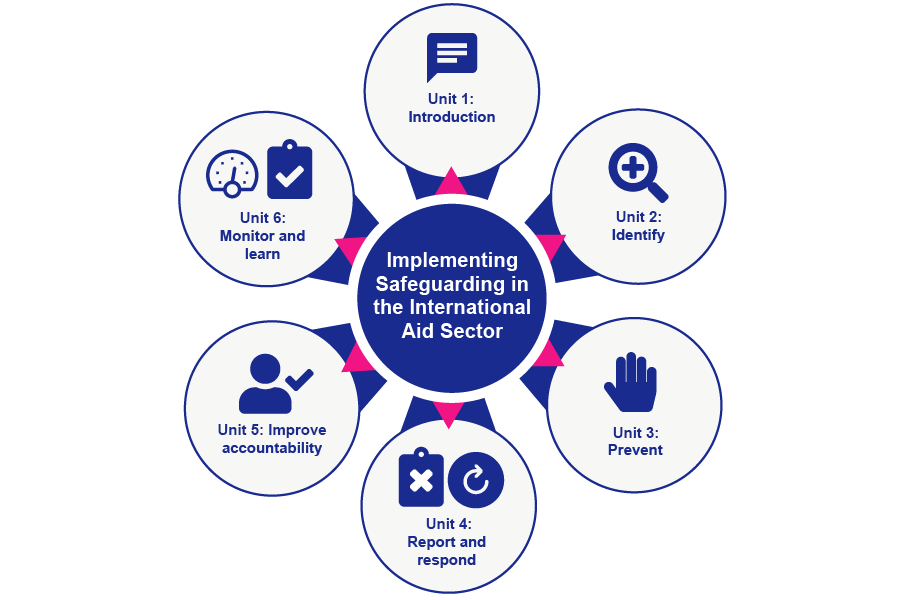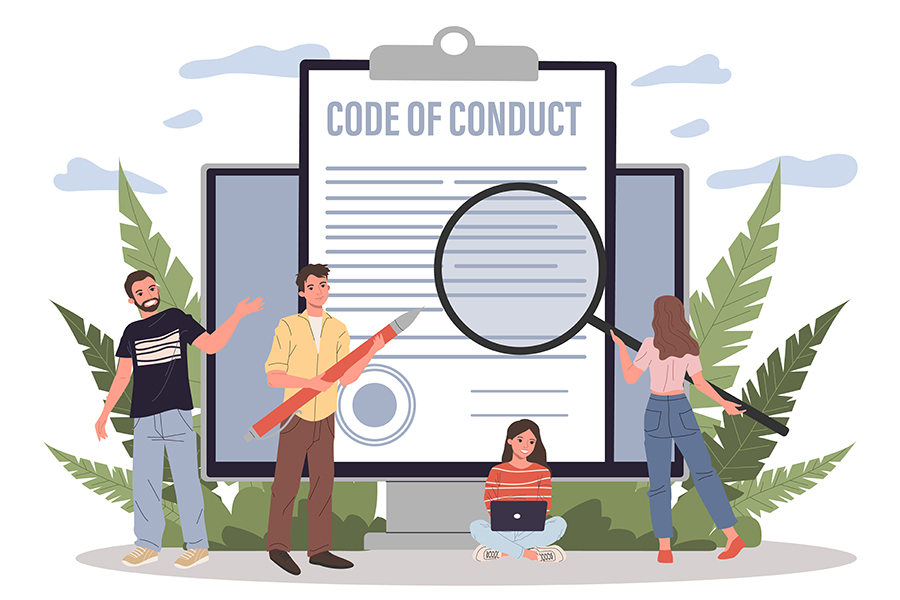Unit 1: Introduction
| Site: | OpenLearn Create |
| Course: | Implementing Safeguarding in the International Aid Sector |
| Book: | Unit 1: Introduction |
| Printed by: | Guest user |
| Date: | Tuesday, 25 November 2025, 3:10 PM |
Introduction
Welcome to Implementing Safeguarding in the International Aid Sector, the second course in this series of three safeguarding courses.
This course, like the other two, was first offered on FutureLearn as Mass Open Online courses (MOOCs). This is why some of the videos refer to these courses as MOOCs.
These MOOCs have been adapted for learning on OpenLearn Create in order to be available for study at any time, in any place and at your pace – thereby providing great flexibility.
Another difference is that on FutureLearn the courses were offered at set presentation times facilitated forums. On OpenLearn Create the facilitated forums are not available because of the flexibility of start dates that are offered. But some of the discussions and learning from those facilitated forums have been integrated into this OpenLearn Create course through activities and enhanced teaching content.
1.1 What's this course about?
![]()
Watch the video above in which the Lead Academic, Jan Webb, welcomes you to this course and gives you an overview of what you will be learning about
This course is intended for learners who already have some knowledge and experience of safeguarding, therefore, if you do not, we strongly recommend learners complete the introductory course Introduction to Safeguarding in the International Aid Sector first. The first course is a good refresher on important introductory concepts, principles and standards of safeguarding whilst working in the development and humanitarian sectors.
This course provides a mixture of theory, practical applications using case studies, adapting tools, and examples of good practice to support you and your organisation in implementing safeguarding policies and procedures, with a focus on sexual exploitation and abuse and sexual harassment
The examples of implementation in this course are set against different types of programmatic work and activities that your organisation might be involved in. For example, data collection and research, gender-based violence programmes, and health, water and sanitation. The ways in which these are approached may differ depending on the context and countries that organisations work in.
This course has been designed for those of you who are working in the development or humanitarian contexts, whatever role or position you may be in but particularly for those with particular responsibility for safeguarding. It will equip you with the skills and tools you need to prevent, report, respond, communicate, be accountable for, monitor and learn when implementing safeguarding in the work that you do.
![]()
The course focuses on your organisational duty of care to prevent and respond to harm that may arise due to the inappropriate conduct of staff on each other or in the communities they have direct and indirect contact with.
By the end of this course, you will be able to:
- Mitigate and prevent against safeguarding risks associated with your work.
- Design or adapt tools to implement activities that minimise harm to those who have direct and indirect contact with your work or organisation.
- Respond to challenges relating to safeguarding concerns using a survivor-centred approach.
- Support accountability to those who benefit from your work, and in the international aid sector more generally.
Over the next 6 units of this course, you will take a journey of 24 hours of learning divided into 3–4 hours per unit although you can study the course at your own pace.
The outline of the course content looks like this:

1.2 Meet the authors

© elenabs / iStock / Getty Images Plus
This course has been created by The Open University in partnership with the Foreign, Commonwealth and Development Office (FCDO) in the UK. It draws on the experience and expertise of practitioners and academics in the international development sector.
Aneeta Williams is an international human rights lawyer and expert in safeguarding children and vulnerable adults, gender and sexual violence, and human rights and IHL in the international aid sector.
Janet Webb is the Associate Head of School for Nursing and Health Professions at The Open University and has extensive experience of teaching and developing safeguarding and child protection courses.
Susan Fawssett is an Open University tutor and a seasoned development researcher. She works extensively with international development organisations to deliver training and author teaching materials.
Andy Rixon is a Senior Lecturer in the School of Health Wellbeing and Social Care at The Open University, specialising in children, young people, and families. Andy has a background as a social worker.
1.3 Learning on this course

How to get the best out of some of the features of this course
Throughout the course you will come across links to external web pages that navigate you away from this course. We recommend that you hold down the Ctrl button on your keyboard and click on the link with your mouse to open the web page in a new window. In this way you can keep your course open in one window and view the new content in a separate window without losing where you are on the course.
The course will also contain learning resources and tools that can be downloaded as you progress that will assist you in learning and implementing the process. You can easily find the tools and templates for each unit under the blue contents bar.
There is an opportunity to obtain a free Statement of Participation and Digital badge at the end of the course. You will need to read through every page of the course and score 80% or above in the quizzes to receive the badge and statement of participation.
Note: The funding for this course has come from the Safeguarding Unit in the UK Foreign, Commonwealth and Development Office (FCDO), which focuses on tackling sexual exploitation, abuse and sexual harassment (SEAH) in the international aid sector. However, similar to course 1, this course is relevant to other forms of harm as well.
|
Learning Journal To enhance your learning, you are asked to keep a learning journal for this course in which you can make notes on:
Your learning journal is personal to you, and it should be useful to you. You may want to share parts of it with a friend or colleague. There are no rules for keeping a learning journal – some days you may write a great deal, and at other times only a little. However, you are advised to write notes in such a way that you can understand them later. This is because we see this course as a starting point for your professional development. There are lots of practical ideas for you to try and we hope you will keep practising the techniques that you learn. In this way, you will have a reference to the things you have learnt even when you are away from a computer. You can keep your journal in a format that appeals to you and is easy for you to maintain – it could be an ordinary paper notebook or on a desktop or mobile device. |
1.4 Keeping safe on this course
The themes and content of this course can inevitably be disturbing to learners. It is important that you are prepared for this, particularly when you watch or listen to the audio and visual materials.
Remember:
- Safeguarding is an emotive topic, which may give rise to feelings such as shock, anger or sadness.
- It is important to manage your own feelings so that you are able to act appropriately, professionally and in the best interests of the survivor/victims(s).
- Studying a course such as this can bring up painful memories from our own past, and this is something you need to be aware of from the start. Should this be the case as you progress through the course, please ensure that you seek support from the resources and support available to you within your organisation or seek professional help (if available).
1.5 Starting your learning journey
This section explores your reasons for studying this course and considers what you already know about safeguarding.
|
Activity 1.1 What’s your motivation for taking this course?
Please consider the following questions – this is a good time to start using your learning journal:
The activity which follows this one – reviewing what you already know – might help prompt issues you would like to add to your list. |
|
Activity 1.2 What do you already know?
We would like to capture your knowledge, expertise and experience before you start this course. It’s important to us as the authoring team to capture what you already know, your motivation for doing this course and your confidence level when going into this course to ensure the content is appropriate to its intended learners. So please Ctrl + click on this pre-course survey that will take about five minutes to complete. It’s also really important that you complete the course and provide your feedback in the post-course survey at the end of Unit 6, so that we can continually improve the course. Your feedback will additionally help the academic team gauge if this course has made any difference to your knowledge, skills, practice or your confidence level, but please don’t worry; all responses are anonymised so we will not be able to know or identify individual respondents. Thank you in advance! |
1.6 What is safeguarding?
This part of the course unpacks in more detail what you know about safeguarding, particularly international standards and their application.
What is safeguarding? An animation
![]()
|
Activity 1.3 What does ‘safeguarding’ mean to you? The word ‘safeguarding’ refers to putting in place measures to prevent and respond to harm that may occur to people that your organisations may come into contact with. Putting safeguarding measures in place will include making a commitment to stamp out harm in our organisations, putting in place rules on how we recruit staff and our organisational representatives, and having a code of conduct signed by staff which effectively governs their expected behaviour. Aid workers have access to and/or control over resources and services, and some workers have misused this position of trust to exploit, abuse and harass children, vulnerable adults and other staff. Reflect and respond to these questions in your learning journal:
|
What are safeguarding standards?
There is no international law or policy that works across all countries to govern what organisations can and should do to prevent and respond to safeguarding concerns.
Thankfully, international and national organisations working in development and humanitarian sectors can look to international standards which can be adopted into organisational policies that will support them to be in a better position to prevent and respond to harm.
These standards have been formulated to ensure organisations:
- Undertake safe selection and recruitment processes.
- Develop clear codes of conduct that set up expected standards of behaviour.
- Develop reporting mechanisms that are accessible and confidential.
- Deal professionally with cases and consequences of misconduct by understanding how to implement these policies and procedures effectively.

© gmast3r / iStock / Getty Images Plus.
Most organisations have a set of organisational values that support the way they work, although these values are not binding.
When it comes to safeguarding children, vulnerable adults and staff, national law is an important reference point. However, enforcement of that law may be lax and not all instances of misconduct are criminal in nature.
Therefore, it’s important for us to look to safeguarding standards to help us develop rules of behaviour in the work that we do so that we can hold ourselves accountable when working with children, vulnerable adults, and with each other.
![]()
Here is a list of international safeguarding standards which are relevant to organisations:
Inter-agency Standing Committee (IASC) Task Force 6 Core Principles on Preventing Sexual Abuse and Exploitation (amended in 2019) and the accompanying Minimum Operation Standards (also available as a PDF download at the bottom of this page) – these principles reinforce the UNSG Bulletin Eliminating Sexual Exploitation and Abuse and now apply across the international aid sector.
In 2018 and 2019 the major governmental donors who form the Development Assistance Committee (DAC) of the OECD agreed that their work on safeguarding should be strengthened as a result of certain cases that were highlighted in the press. So, all of their partners should adhere to the IASC 6 Core Principles (mentioned above) and/or the Core Humanitarian Standard (CHS) on Quality and Accountability focused on Preventing Sexual Exploitation, Abuse and Harassment (PSEAH) and greater accountability to communities.
Institutional donors have also included their own safeguarding requirements for organisations which receive funding from them as part of their due diligence processes and require them to provide evidence of their continued adherence. The notable donor requirements are the Foreign and Commonwealth Development Office (FCDO) Enhanced Due Diligence Standards and the DAC Recommendation on Ending SEAH in Development Co-operation and Humanitarian Assistance: Key Pillars of Prevention and Response.
For standards when working with children and/or vulnerable adults around behaviour, you might also want to refer to the UK charity Keeping Children Safe and their published standards. For those working on research and data collection, refer to the UK Research and Innovation (UKRI)’s Safeguarding Standards.
|
Activity 1.4 International safeguarding standards Read the Resource and Support Hub (RSH) summary brief International Standards on Sexual Exploitation, Abuse and Sexual Harassment, which outlines the various safeguarding standards. Record your thoughts to the following questions in your learning journal:
|
Application of international SEAH standards
Those of you who completed the first introductory course will remember that we discussed how important it was for organisations to develop their safeguarding policies and procedures based on the international safeguarding standards you have just been reading. The course provided several checklists and activities to support learners in thinking about not only what should be in the policy but also how it would be applied in the work your organisation was involved in.
There are many instances where organisations have failed in their duty to prevent and respond appropriately to harm to people the organisation has contact with (namely staff, associated personnel, children and vulnerable adults). These international safeguarding standards have therefore come about to support organisations to implement safeguarding measures wherever they may be operating, and whatever their context.
|
Activity 1.5 Applying safeguarding standards Read this article on How to apply SEAH sector standards (PDF). It provides an overview of safeguarding standards focused on preventing and responding to sexual exploitation, abuse and harassment (SEAH). Use it to see if it can help you review the application of these standards within our own organisation. |
1.7 The safeguarding cycle
When managing safeguarding in a programme or project, aid workers have a lot to think about.
Most organisational policies tend to only talk about ‘top lines’ regarding organisational commitments, leaving those working in the field to interpret these commitments into realistic actions to ensure programmes are safe.
To help learners with how to implement organisational policies in their work, this course has mapped the journey by way of a ‘safeguarding cycle’.
![]()
Watch the video above, and as you do, think about what you would include in the different components of the phases of the cycle.
You will note that the ‘safeguarding cycle’ follows a similar template to the ‘project management cycle’ (PMC), which many of us working in development or humanitarian sectors may already be familiar with.
PMC is a project management approach that addresses the complexities of a project through all its phases while maintaining alignment with the strategy and objectives agreed upon by stakeholders (for example, donors, partners, the community) at the outset.
PMC helps structure and determine the phases of the project, as well as how to approach tasks in those phases. Using the PMC approach, we hope that this will help you better understand how to incorporate safeguarding principles into the work that you do during your projects and activities.
We explore more of this later in the course. We will also explore how to implement the various safeguarding principles, standards and tools against this backdrop.
The safeguarding journey

People working in or representing organisations possess power and influence over others for a variety of reasons: their gender, race, role/position in the organisation, employment status, nationality, language and education.
Most of those who are in leadership positions, for example, make decisions on who receives jobs, services and resources, and could misuse this power for their own advantage or gain.
People with less power are usually those who are already vulnerable, either because of personal circumstances such as age, ethnicity, disability, role/position, employment status, nationality (or lack of), language and education, as well as possibly external circumstances such as displacement, armed conflict, or lack of opportunities to have their voices heard or trusted.
Keeping people safe when working with vulnerable communities can be seen as a journey. It takes attitudinal and behavioural changes, and that’s not easy to do, especially if we as aid workers have greater power than others that we work with. This is why safeguarding is seen as an organisational journey and using standards and tools will support our work to be safer for the communities that we serve and support, as well as ensuring they are viewed and treated as partners in this endeavour.
![]()
Further reading
The Safeguarding Journey: An Introduction to Safeguarding Resource & Support Hub (RSH)
1.8 Implementing safeguarding
Managing safeguarding issues often means balancing the rights and needs of many people.
Fortunately, we can rely on safeguarding standards to focus our minds when making decisions in the best interest of survivors and ensuring we mitigate against any greater harm.
|
Activity 1.6 Case Study
Watch the video above on the Cox’s Bazaar refugee camp in Bangladesh. This animation is part of an awareness campaign against the abuse of power and sexual harassment of aid workers. The video illustrates how an aid worker misused his power by demonstrating favouritism and coercion leading to sexual harassment, which made a beneficiary very uncomfortable and the environment unsafe, not only for her but for others too. As you watch, note your responses to the following questions in your learning journal:
|
1.9 Unit 1 Knowledge check
The end-of-unit knowledge check is a great way to check your understanding of what you have learnt.
There are five questions, and you can have up to 3 attempts at each question depending on the question type. The quizzes at the end of each unit count towards achieving your Digital Badge for the course. You must score at least 80% in each quiz to achieve the Statement of Participation and Digital Badge.
1.10 Review of Unit 1

© Feodora Chiosea / iStock / Getty Images Plus.
In this first unit of Implementing Safeguarding in the International Aid Sector, you have familiarised yourself with the learning objectives, understood how this course has been developed, reflected on your motivations for learning with us and learnt how to keep yourself safe online.
In terms of the content, you have reviewed your understanding of what the term ‘safeguarding’ means and the notion that aid workers have power and how misusing that power can cause harm and injury. We explored the ‘safeguarding cycle’ which outlines this course, as well as what and how international safeguarding standards may be applied to your organisational policies, procedures and practice.
In Unit 2 you will learn about identifying and recognising vulnerability, and the risks related to the work that you do when coming into contact with vulnerable communities. You will explore this using case studies, such as data collection and research, and discover how safeguarding should be incorporated into such work.
|
Before you move on to Unit 2, we would like you to reflect on and record your own learning experience on this course by considering the following questions in your learning journal
|
Now go to Unit 2: Identification.
References
Safeguarding Support Hub (2021) International Standards on Sexual Exploitation, Abuse and Sexual Harassment, Online. Available at Resource and Support Hub (PDF) (Accessed 23 June 2021).

